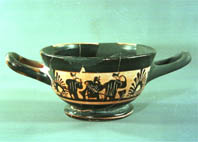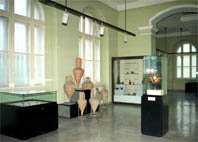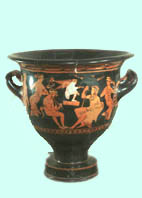|
|
|
The
Establishment of Odessos
The Town
during the Archaic and the Classical Period
/6th – 4th century
BC/
|
|
|
According to an early written record Odessos /nowadays
Varna/ was established by migrants from the Asia Minor town
of Milet /cont. Miletas/ at the time when Mydia was reigned
by czar Astiag – the second fourth of 6th century BC. Archaeological
excavations confirm the record. This is the period of the Great
Greek Colonization.
The name of the town /Odessos – a settlement on water,
"Watery"/ is not Greek but of an earlier linguistic origin
which suggests the presence of an older village on the same territory.
The development of the town was typical for the classical polis town-state,
independently governed. In almost no time Odessos becomes one
of the most important port and trade centers at the Black Sea.
The Thracian tribes of Krobizi populated the vicinity of the
town. The imported ceramic vessels found on the territory of the ancient
town suggest the most important trends of trade relations. During
the first decades they aim mainly to the mother country – the town
of Milet and the nearby territories on the western coast of Asia Minor
but from the early 5th century BC priority was taken by the trade
import from Athens.
 |
The Atik black-figured and red-figured vessels
decorated the tables of the ancient Odessos citizens.
Olive oil and wine have been supplied from various parts of
the Mediterranean and the Black Sea. Discovered are
many amphorae – vessels for carrying wine on board the ships
originating from the isles of Hios, Rhodos, Samos, Lesbos,
Tassos, Heraklea Pontiiska and Sione. |
|
An interesting Dionisius scene decorates
a red-figured krater vessel from the 4th century BC found
in grave in the necropolis of Odessos representing the god
Dionosius sitting over his chimation and panther fur surrounded
by his suite of maenads and satyrs. A nude Eros presents him
with a wreath. On another krater vessel from the same period,
also from the necropolis of the town, the goddess of victory
Nike is depicted awarding a winner in a competition. He is
behind the goddess on horseback just received a wreath as
a prize.
Architectural details /Ionian capitals/ from the 5th
century BC suggest the existence of an early temple in the
town. This should be the temple of Apollo known from some
written records. Initially Apollo was a supreme deity of town.
His bynames of Apollo Ietros /a healer, a protector/ and Apollo
Delfiniy are quite explicit to his functions in the religious
notions of the ancient.
The contacts of Odessos with the native Thracian population
are well expressed by the presence of numerous works of the
toreutics – metal decorations for horse trappings worked out
in the typical for the Thracian art geometrical animal style,
bronze and silver earrings, rings, bracelets, fibula and others. |
|
|
| À
r c h e a e o l o g i c a l m u s e u m V
a r n a |
|
www.varna-bg.com
© 1997, 2000; 2002
|
|



